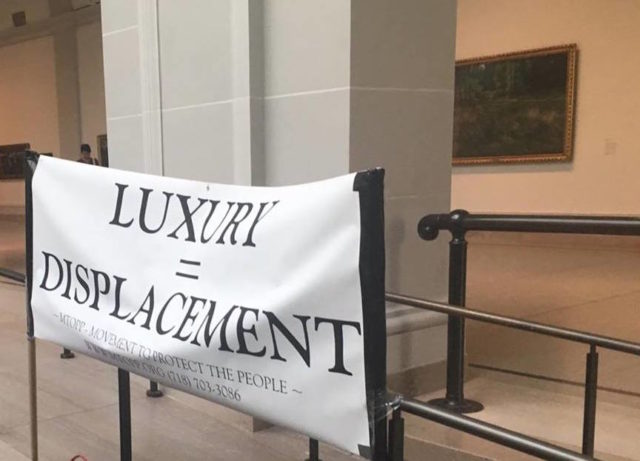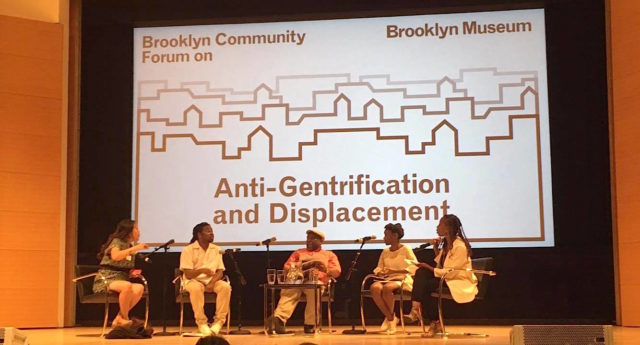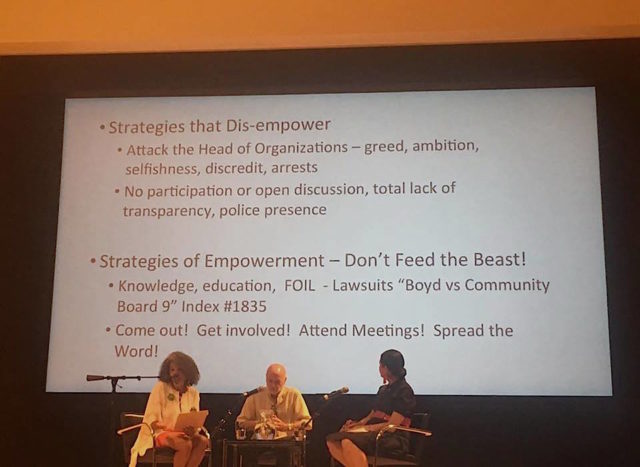
The Movement To Protect The People’s Alicia Boyd (standing) leads a small group discussion at the Brooklyn Community Forum on Anti-Gentrification and Displacement (all images by author for Art F City)
Is gentrification inevitable? Or is that just a myth perpetrated by greedy real estate developers and politicians who seek to gain from residents’ fear and inaction? The answer is undoubtedly the latter if Sunday’s Brooklyn Community Forum on Anti-Gentrification and Displacement is any indication.
The anti-gentrification conference shattered the notion that gentrification is a “done deal,” as panel moderator and Director of Hunter College Center for Community Planning and Development Tom Angotti described. Held at the Brooklyn Museum, activists and community organizers, instead, offered a glimmer of hope for displaced and threatened communities.
This was achieved through an afternoon of panels, performances, a participatory workshop on how cultural institutions can support communities and round tables for small group discussions. The Movement to Protect the People (MTOPP)’s Alicia Boyd was instrumental in the organization of the conference, which was co-presented with Artists of Color Bloc, Brooklyn Anti-Gentrification Network (BAN) and select artists from the museum’s current protest-centric Agitprop! exhibition. The conference’s multifaceted approach allowed for an almost unheard of level of intimacy and personal engagement between grassroots activists and attendees. After the events at the museum, there was even a solidarity march that concluded with a picnic in Prospect Park.
Beyond the panels and discussion groups, conference attendees and unsuspecting Brooklyn Museum viewers were met with an unlikely sight in the museum’s third floor atrium. Activist organizations set up dynamic booths with banners emblazoned with phrases such as “Luxury=Displacement” and “Culture is Autonomy, Autonomy is Revolution.” The crowded booths lining the atrium overflowed with flyers and announcement for future events.

“Luxury = Displacement” at the MTOPP Booth in the Brooklyn Museum’s third floor atrium
Despite the visible enthusiasm from the Brooklyn Museum staff on Sunday, the conference was hard-won. The forum was organized as a direct response to the 6th Annual Real Estate Summit. This developer-driven summit was hosted at the Brooklyn Museum last November, which drew demonstrations from BAN and other community activists and artists including the Artist Studio Affordability Project (ASAP). [Full disclosure: AFC was involved with organizing the evening’s protest.]
Brooklyn Museum Director Anne Pasternak agreed to provide space for an anti-gentrification summit, as well as include an installation by the activist-artists in Agitprop! However, the conference organizers endured subsequent pushback from the museum, which demanded more arts-focused programming. The activists also had to agree to not criticize the museum. And then, on July 10–the original date set for the conference, an air conditioner forced yet another delay. Even with these setbacks, Sunday’s conference was surprisingly well attended even on a boiling summer afternoon.
The events largely centered around two panels–Effects of Gentrification and Displacement and Successful Strategies and Stories on Rezoning and Development. According to their introduction, the first panel would supposedly demystify gentrification while the second revealed means of resistance. There was significant overlap. Rather than developers plotting how to “create value” in Brooklyn like the Real Estate Summit, participants asserted that the communities, primarily communities of color, already have value that must be protected.
Thankfully, the conference was not made up of primarily white panelists and new residents discussing the displacement of communities of color–a common occurrence in many art circles. The panels, instead, reflected the racial and ethnic diversity of the neighborhoods themselves. And with the continued underrepresentation of people of color in art institutions, a stage full of activists of color in the Brooklyn Museum’s auditorium presented a meaningful, symbolic sight.

Effects of Gentrification and Displacement panel featuring (from left to right) Betty Yue, Imani Henry, Rob Robinson, Havanna Fisher and Catherine Green
For the most part, panelists avoided discussing art, though there were notable exceptions. CAAAV Organizing Asian Communities’ Betty Yue, for example, called out the gallery newcomers in Manhattan’s Chinatown. Yue discussed the development of Chinatown as an “ethnic enclave” of working class Chinese immigrants who are now being pushed out of their homes. An artist herself, Yue had strong words for the around fifty galleries she noticed arriving in the neighborhood in the past three years. She pointed out that the galleries “are not serving our interests.” “You don’t need to bring anything to us. We’re here,” she declared.
Yue was a part of the first panel Effects of Gentrification and Displacement, which emphasized that gentrification threatens much more than people’s homes. Gentrification should be understood as both a form of trauma and, as moderator Rob Robinson argued, “ethnic cleansing”. Confirming Robinson’s comment, the panel provided examples of how residents’ lives are at stake. The elderly are particularly vulnerable to predatory landlords who leave older residents–sometimes fatally–without heat or air conditioning in an effort to push them from their homes.
Mostly, though, panelists focused on more practical strategies to deal with displacement and gentrification. Perhaps the potential for learning tangible solutions to combat gentrification accounts for the influx of attendees at Sunday’s conference. There really isn’t a blueprint for resisting development. If gentrification is not a forgone conclusion, then what? How do you fight back?

MTOPP’s Alicia Boyd lays out strategies of resistance in the second panel Successful Strategies and Stories on Rezoning and Development with Tom Angotti and Ana Orozco
Alicia Boyd provided the most concrete tools to address rezoning at the Successful Strategies and Stories on Rezoning and Development panel. Boyd was a part of the team of community members that prevented the rezoning of her Prospect Lefferts Garden neighborhood. This neighborhood marks one of the only communities that successfully halted rezoning.
Boyd explained that in order to dissuade developers, you have to stop the city from even beginning the rezoning process. Rezoning leads to changes in the infrastructural regulations and this opens up the possibility for development. The first step to rezoning is the city’s neighborhood planning study and, as Boyd asserted, “You start the study, you’re done.” Recommending that communities refuse to allow the completion of these studies, Boyd encouraged residents to “stop being nice.” She said, “Don’t feed the beast. Don’t even let the process happen…The key to your community is you have the right to say no.”
Boyd represented one of the few concrete anti-gentrification success stories of the day. This cold fact reveals the difficulty of fighting city government and developers. And yet, it also proves that gentrification prevention isn’t impossible. While they may or may not always be successful, there are at least methods to confront gentrification even though it may take an extended period of time to see any results. As Tom Angotti correctly explained, “There are no quick fixes or immediate solutions.”
The panelists also insisted that new residents and allies get involved with political actions, attend their local community board meetings and pay attention to who is being displaced in their neighborhoods. Imani Henry from the Brooklyn Anti-Gentrification Network highlighted the importance of intersectionality in fighting gentrification. “They’ll first come for our grandmothers and families, and then the young people,” he said, “New residents get down with us because this is your struggle too. This is all of our struggle. This is all of our fight.”


Comments on this entry are closed.